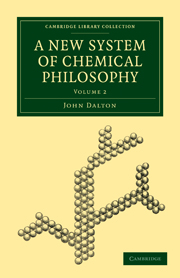CHAP. V - COMPOUNDS OF TWO ELEMENTS
Published online by Cambridge University Press: 13 June 2011
Summary
SECTION 13
METALLIC OXIDES
All the metals are disposed to combine with oxygen, but the combination is effected more easily with some than with others; the compound is usually called an oxide, but in some instances it is also called an acid. The same metal combines with one, two, or perhaps more atoms of oxygen, forming compounds which may be distinguished according to Dr. Thomson, by the terms protoxide, deutoxide, tritoxide, &c.
Such however is the repulsion of oxygen to oxygen that we rarely find three atoms of it retained by a single atom of any kind; and there are not many instances of metals capable of holding two atoms of oxygen. Various modifications of the proportions of metals and oxygen arise from the combinations of the oxides themselves one with another and with oxygen, so as to lead some to imagine that an atom of metal in some instances combines with 3, 4, or more of oxygen. This is altogether improbable: It is much more simple to suppose that one atom of oxygen connects two or more atoms of protoxide, 1 of protoxide unites to 1 or more of deutoxide, &c. These intermediate oxides are in few if any instances found to combine with acids like the other two oxides.
There is no reason that I am acquainted with for disbelieving that oxygen combined with a metal is still repulsive of oxygen, and that by the same law as particles of an elastic fluid; that is, the repulsion is inversely as the distance of the centres of the atoms.
- Type
- Chapter
- Information
- A New System of Chemical Philosophy , pp. 1 - 267Publisher: Cambridge University PressPrint publication year: 2010First published in: 1827



